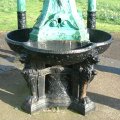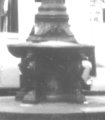|
 |
|
| |
 |
|  |
|
Details:
|
|
|
Also known as: Little Folks Fountain
Manufacturer:
Walter Macfarlane & Co
(fl. 1850-1965)
Location: Junction of Seamore Street and Maryhill Road, Glasgow
Date erected: 1898
Date destroyed: c.1980
Archive Photographs: Ronald T. McIvor, 1967
|
|
Queen Victoria Drinking Fountain (Little Folks Fountain)
|


| |
The fountain was erected by the readers of the Little Folks Magazine to commemorate Queen Victoria's Diamond Jubilee of 1897, and was known locally as the Little Folks Fountain. Multi-tiered and made of cast-iron, the fountain was surmounted by a statue of the Queen, and stood on an island at the junction of Seamore Street and Maryhill Road, until around 1980 (the building with the cupola was the Seamore Cinema on Maryhill Road, which also disappeared at the same time).
The Little Folks was a magazine for boys and girls published in London (1871-1933), which encouraged the nation's youth to donate money to institutions and projects to better the lives of the less fortunate, such as children's homes and hospital wards and amenities such as public drinking fountains.
|



| |
The children of Glasgow's contribution was their scheme to provide the people of the working class districts around St George’s Cross with a constant source of drinking water from a prominently placed fountain. The Queen’s jubilee was the catalyst for thousands of sculpted monuments to the event throughout the country, and it was decided that the fountain should also be dedicated to the Queen and her sixty year reign, as a mark of loyalty from her youngest and humblest subjects.
As grand a monument as the children could afford, the fountain was built from parts ordered from the trade catalogues of Walter Macfarlane & Co., which mass produced them at their nearby Saracen Foundry in Possilpark. Interestingly, the column was identical to the lamp standards used at the Mitchell Theatre (formerly St Andrew's Halls, Granville Street), and the base was of the type used for the foundry's mass-produced, canopied drinking fountains; a good example of which is the Bailie Martin Fountain in Glasgow Green. [Pictures of these parts are reproduced above for comparison.]
|




| |
The identity of the sculptor of the statue of Queen Victoria is not known. However, a tentative attribution to
James Alexander Ewing
can be made on the basis that he is known to have produced portrait busts for the foundry's other fountains.
|


| |
Although the exact date of the fountain's inauguration has also yet to be found, it is known that Glasgow Corporation’s Water Department agreed to provide its water supply free of charge on 3 October 1898. About sixty years later, the fountain, together with many others in Glasgow, was turned off and sealed up in the early 1960s, due to hygiene and maintainance concerns. Largely forgotten by historians and surprisingly overlooked by photographers, the Little Folks Fountain was eventually demolished when the area was redeveloped in the early 1980s.
The photographs featured above, taken by Ronald T McIvor in 1967, constitute a unique record of the fountain, and the team at glasgowsculpture.com are grateful to him for the opportunity to reproduce them.
|
|
Click on an image to enlarge it.
|
Click here to return to the TOP.
|
|
|
All images and biographies are our copyright and may not be reproduced
in any form whatsoever without our express permission.
|
|
|
|
|
For sculpture and architecture: we have over 300 biographies of sculptors and architects connected with Glasgow, Scotland.
|
|
| Copyright 2001-2024 glasgowsculpture.com. |
|
|
| |
|
 |
|

